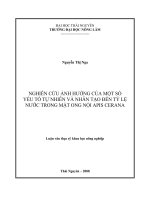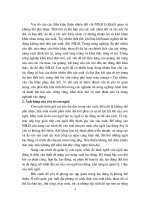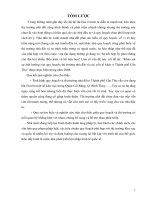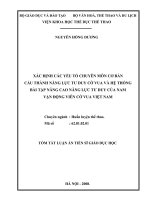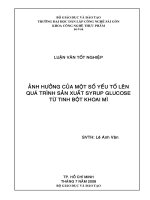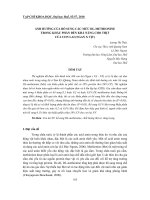Anh hương tuoi ga va cac yeu to khac len dd trung va khả năng nở
Bạn đang xem bản rút gọn của tài liệu. Xem và tải ngay bản đầy đủ của tài liệu tại đây (812.95 KB, 9 trang )
EFFECTS
OF OVIPOSITION TIME,
HENAGE,AND EXTRA
DIETARY
CALCIUM
ON EGGCHARACTERISTICS
AND HATCHABILITY
R. !I NOVO, L. 'E GAMA, and M. CHAVEXRO SOARES'
Instituto Superior de Agronomia, 1399 Lisboa Codex, Portugal
Phone: (01) 3638161
F M : (01) 3635031
measured by SG and eggshell weight [8, 91.
DESCRIPTION
OF PROBLEM
Reis et al. [6] also observed that coarse limeEggshell quality as measured by egg
specific gravity (SG) has frequently been
associated with hatchability of eggs from
broiler breeder hens [l, 2,3,4,5,6]. Research
indicates that a SG of 1.080 is the dividing
point between good and poor hatchability
[7]. Researchers have reported that broiler
breeder hens fed in the afternoon exhibit a
sig&cant improvement in eggshell quality as
1
To whom correspondence should be addressed
stone supplied in the afternoon slightly increased the SG of broiler breeder eggs, but
markedly improved embryo viability.
The literature also indicates that SG of
broiler breeder eggs increases as time of laying
becomes later in the day [l,21, althoughhatchability of eggs laid in the afternoon is not
significantly greater than that of eggs laid
during the morning [l]. However, further
Downloaded from by guest on June 30, 2014
Primarv Audience: Breeder Production Managers. Researchers
EXTRA DIETARY CALCIUM
336
same feed in separate sex feedings [15], as
diets used by the breeder hen appear to have
no detrimental effects on male performance
[14]. All ration feeding occurred at 08:30 hr.
Hens received approximately 163 and 157 g
of feed per bird at 46 and 65 wk of age respectively, to maintain body weights recommended by the primary breeder [16]. The
hens had consumed their feed allowance by
approximately 11:OO hr each day. All birds
consumed water ad libitum. In the pen assigned to CS treatment, coarse limestone
(4 g/bird daily) was scattered on the litter at
16:30 hr. The litter was made of naturally dark
wood shavings (eucalyptusbark), so that white
limestone particles were very visible; the
birds rapidly consumed them. The Limestone
supplement had particles ranging from 2 to
5 mm in diameter, with an average solubility of
37.3+3.3% (five repetitions) determined as
described by Keshavarz et al. [lq.Extra dietary calcium supplement was provided for
8 consecutive days at both 46 and 65 wk of
flock age. Calcium distribution began 3 days
before the date of first egg collection for
experimental purposes (Table 1).
EGG COLLECTION AND HANDLING
At 46 and 65 wk of age eggs were collected
for 5 and 4 days, respectively (Table l),at 2 hr
intervals beginning at 08:OO hr and ending
at 18:OO hr. Eggs laid before 08:OO hr were
removed from the nests and were not used
in this experiment. Eggs that were cracked,
very dirty, misshapen, or of extreme size
were culled. From each pen and collection
time, a random sample of 150 hatching eggs
was obtained and eggs were then individually
marked. Eggs from each day’s production
reached the hatchery at 12:45, 16:45, and
18:45 hr. The eggs were then individually
weighed to the nearest 0.1 g, and SG was determined in graded sodium chloride solutions
kept at room temperature (about 20°C) and
ranging from 1.060to 1.090,with an increment
of 0.005 units between successive solutions.
The concentration in which the egg barely
floated beneath the surface indicated egg
SG. Eggs that did not float in any of the solutions were assigned a SG of 1.095, and those
that floated in all solutions were assigned a
SG of 1.060.After SG measurement, the eggs
were rinsed in warm tap water and dried in a
stream of warm air at approximately 20°C.
MATERIALS
AND METHODS
SOURCE OF EGGS
The study was carried out over two periods, from November to December 1994 and
from March to April of the following year,
using eggs from one commercial flock of approximately 13,900 broiler breeder hens
(Cobb 500) at 46 and 65 wk of age. Equal
numbers of birds were arbitrarily assigned to
each of two identical pens of one building at
0.25 m2 per female, in order to determine the
effects of two treatments: no extra calcium
supplementation (NC) and extra calcium
supplementation (CS). Natural daylight was
supplemented with artificial light to give a
16 hr photoperiod (on 0790 hr, off 23:00 hr).
Daily low and high in-house air temperatures
ranged from 17 to 24°C and 16 to 24°C at ages
46 and 65 wk, respectively.
All birds received a commercial broiler
breeder diet (16.50% CP, 2800 kcal ME,/kg,
3.10% calcium, 0.35% available phosphorus)
formulated to meet or exceed National Research Council [14] requirements, as previously described [6] . Both sexes received the
Downloaded from by guest on June 30, 2014
studies showed that hatchability [lo] and
embryo viability [ll]were si&icantly lower
in fust-of-sequence eggs than in subsequent
eggs within a laying sequence. The fust egg of
a sequence is usually laid relatively early in
the day and the remainder laid later on each
following day; therefore, a high proportion of
eggs laid in the early morning of any given
day should be first-of-sequence eggs [12]. In
addition, sequence length in feed-restricted
broiler breeder hens reaches a prime mean
length at 32 wk of age, then quickly shortens
with advancing hen age [13]; therefore, the
incidence of first-of-sequence eggs increases
with hen age.
We conducted the present study to determine the effects of oviposition time, hen’s age,
and extra dietary calcium on egg weight (EW),
SG, EW loss during the first 18 days of incubation, fertility, embryo viability, age of embryonic death in fertile eggs, and hatchability
of eggs from feed-restricted broiler breeder
hens under commercial conditions. Specifically, we wished to ascertain whether the effect
of calcium supplementation varied with hen
age by affecting SG and with time of oviposition through interaction with time of calcium
absorption.
Field Report
337
NOVO et al.
TABLE 1. Egg collection and calcium supplementation for broiler breeders at two different periods (46 and
X
X
April 5
-
X
November 24
X
X
April 6
X
X
November 25
X
-
April 7
X
-
Eggs from each treatment and collection
time were then placed in setter trays
(150 eggshay).
INCUBATION AND HATCHING
Incubation was initiated at 2200 hr on the
day of egg collection in electronically controlled single-stage incubators (Petersime
576). The ten experimental trays corresponding to five different collection times and two
treatments were randomly placed in one
quadrant (front right) on the same trolley,
which was then filled with other eggs. Quadrant and trolley positions were the same on all
9 collection days to reduce possible position
effects. AU eggs were fumigated in the incubator at incubation temperature on the
day of setting, using 20 g of potassium permanganate and 30 mL formalin (400 g/L) per m3
incubator space with the ventilators closed for
20 min. Eggs were automatically turned 90"
every hour and incubated at conventional
temperature and humidity conditions, as previously described by Roque and Soares [5].
The eggs were individually candled on the
18th day of incubation, using a hand candling
lamp. Infertile eggs and eggs containing early
dead embryos were removed and broken out
for macroscopic examination. The eggs with
apparently living embryos were individually
weighed to the nearest 0.1 g. Weight loss was
calculated by difference and expressed in absolute terms (g) and as a percentage of initial
fresh egg weight. The eggs were quickly transferred to hatcher baskets, randomly distributed in the front part of the same trolley, and
placed in a hatcher (Petersime 192) operated
at conventional conditions, as outlined by
Roque and Soares [5].Chicks and unhatched
eggs were taken off at 21 days and 12 hr
postincubation.
Saleable hatched chicks and culls (unmarketable chicks) were recorded. All eggs
removed at candling, and unhatched eggs at
the time of taking off the hatch, were broken
out, examined macroscopically, and assigned
to one of the following categories: infertiles,
early-dead germs (embryo deaths during 1to
7 days of incubation),mid-dead germs (deaths
during 8 to 18 days), late-dead germs (deaths
after 18 days), pipped (beak penetrated
eggshell but chick did not emerge), and rots
(contaminated). From the data, percent
hatchability (number of saleable chicks
hatched per all eggs set x 100) and percent
embryo viability (number of saleable chicks
hatched per number of fertile eggs set x 100)
were calculated. A total of 7500 eggs were
used in the fust period (150 eggs per collection
time x 5 daily collection times x 5 days x 2
treatments), and 6000 eggs were used in the
second period (4 days).
Data were statistically analyzed by
analysis of variance [18,19,20].
RESULTS
AND DISCUSSION
The interaction between oviposition time
and calcium supplementation was significant
only for embryo mortality up to 7 days and
contaminated eggs (Table 2); thus, it seems
that the effect of ovipositiontime was basically
the same for both treatments. On the other
Downloaded from by guest on June 30, 2014
November 23
JAPR
EXTRA DIETARY CALCIUM
338
TABLE 2. Significance of different sources of variation in the preliminary analysis
VARIABLE
SOURCES OF VARIATION
Treatment
0
Breeder
Age (A)
Oviposition
Time (0)
NS
***
.**
**
..
**.
I**
$8
f..
Egg specific gravity
Egg weight at set, g
Fertility, %
Hatchability, %
I
NS
I
.
.
t
OXT
OXA
NS
*
*.*
NS
NS
NS
***
NS
NS
*
***
NS
**:
*
:**
NS
***
*t
*P<.os; * *P< .01; ***P< .001
hand, the interaction between oviposition time
and age of the hen was signifcant not only
for early mortality and contaminated eggs but
also for egg weight loss, embryo viability,
and hatchability. Interaction of hen age and
calcium treatment significantly affected all
traits except intermediate and late embryonic
mortality and contaminated eggs, which suggests that the effect of calcium supplementation differs according to flock age.
INFLUENCE OF OVIPOSITION TIME
The effects of oviposition time, expressed
as the linear regression coefficients of the variables analyzed on time of oviposition, are summarized in Table 3, either within treatment or
age, or pooled, depending on interaction significance. These results clearly demonstrate
that regardless of hen age, EW decreases
(P < .Ol) gradually as time of laying becomes
later in the day. These data substantiate previous findings that eggs laid in the morning are
heavier than eggs laid during the later periods
of the day [12, 21, 22, 23, 241. Research indicates that this variation in EW with time of
laying is related to the sequence of eggs in the
ovulatory cycle, but not directly related to the
time of oviposition [12]. However, under usual
photoperiodic conditions, it is likely that early
morning ovipositions would include most of
the first-of-sequence eggs [12], which are
heavier than subsequent eggs [lo, 21,251. This
probably occurs because an ovarian follicle
destined to become the first egg in a clutch
resides as the largest follicle (F1) on the ovary
for about 16 hr longer than mature FI follicles
of subsequent eggs in the same sequence [26].
Such a long period of follicular growth is
presumably associated with a greater yolk
deposition, as it occurs in the ovary [27.
Egg specific gravity increased significantly (P< .001) during the day at both ages,
with a slightly higher increase in older hens
(linear regression coefficients on time were
O.OOO4 and O.OOO5 at 46 and 65 wk of age, respectively). These findings are in general
agreement with previous studies involving
laying hens [22, 28, 29, 30, 311 and broiler
breeder hens [l, 21, which showed that eggs
laid in the afternoon have an average SG
greater than eggs laid in the morning. The
reason for this variation is not clear. This increase in SG may be due to a more adequate
calcium carbonate supply directly from the
feed administrated in the morning. Eggshell
calcification of eggs laid in the afternoon occurs in part when the hen has access to feed,
whereas in eggs laid early in the morning the
Downloaded from by guest on June 30, 2014
EmbIyo viability, %
***
TXA
Field Report
339
NOVO et al.
46 wk
0.9247
0.0023+0.0013
NS
65 wk
0.8344
-0.0075f0.0018
***
aDo = Intercept
%,+sb = Linear regression coefficient f linear regression coefficient standard error
D
~ NO ~extra
= calcium supplementation
= With extra calcium supplementation
'Pi.05; **P<.Ol;***P<.OOl
calcium carbonate of the shell is formed at
night when the hen is not eating. This hypothesis is also supported by the work of Farmer et
al. [9], who reported that broiler breeder hens
fed at 16:OO hr had significantlybetter eggshell
quality (SG) than buds fed at 0530 hr.
Flock age affected the relationship of oviposition time to egg weight loss during the first
18 days of incubation. For hens 46 wk of age,
absolute and relative egg weight loss decreased significantly with later laying time.
For hens at 65 wk of age no significant changes
for different laying times were observed when
weight loss was expressed in absolute terms;
however, weight loss as a percentage of fresh
egg weight increased significantlyfor eggs laid
later in the day. The results obtained at 65 wk
of age are consistent with the findings of
Robinson et al. [lo], who used eggs from
broiler breeders 45 to 53 wk of age and observed that eggs laid later in a sequence lost
significantly more weight during the 7-day
incubation period than did first-of-sequence
eggs. This relationship of weight loss to oviposition time may not be attributable to differences in shell quality, since SG increased
through the day (Table 3), and previous
studies showed that eggs with the highest SG
Downloaded from by guest on June 30, 2014
Embryo viability, 70
EXTRA DIETARY CALCIUM
340
on the other hand, there was a si&icant
trend for hatchability and embryo viability
to decrease as oviposition occurred later in
the day, mostly because of increased early
embryonic mortality and mortality due to
infections. These results were unexpected,
because previous studies [2, 3, 4, 5] have reported that thick-shelled eggs had better
hatchability than thin-shelled eggs due to their
greater fertility and lower embryonic mortality, and that the SG of eggs from older hens
increased with oviposition time. Concerning
the relationship between oviposition time and
embryonic mortality, Robinson et al. [lo] reported no significant difference for embryo
viability between first (89.70%) and subsequent (92.75%) eggs in a sequence, and
Fasenko et al. [ll] found that viability was significantly reduced in first-of-sequence eggs
compared to subsequent eggs. The data from
the present research suggest that oviposition
time (egg sequence position) affects viability
of fertile eggs in older flocks through higher
early embryonic mortality, regardless of shell
thickness.
TABLE 4. Breeder age x treatment interaction effect on egg specific gravity, egg weight, survival, hatchability,
and embryo viability
B~~ = NOextra calcium supplementation
‘CS
a x
= With extra calcium supplementation
Means for the same combination effect and row with different suuescriuts differ at P < .OS.
Downloaded from by guest on June 30, 2014
had the lowest weight loss [2,5]. Present data
suggest that besides SG, other egg components may also play an important role in water
loss during incubation. The work of Meur and
Baumann [32] indicates viscous quality of
albumen during the initial stages of incubation
as one possibility.
At both ages, oviposition time did not
sigruficantly influence fertility, intermediate
or late mortality, or percentage of pips. In
their work with broiler breeders housed in
individual laying cages, Robinson et al. [lo]
and Fasenko et al. [111had similar fmdings and
reported that fertility was not significantly
different between first-of-sequence and subsequent eggs.
At the younger age, oviposition time did
not significantly influence early embryonic
mortality, embryo viability, percentage of
contaminated eggs, or hatchability. These
results are in general agreement with the
work of McDaniel et al. [2], who suggested
that in eggs with SG higher than 1.080 there
appeared to be little relationship between
SG and hatchability. In the present study,
younger hens produced eggs with a higher
average SG (1.084) (Table 4). In older hens,
Field Report
NOVO et al.
EFFECTS O F CALCIUM SUPPLEMENTATION
As shown in Table 4, the effects of extra
calcium fed in the afternoon varied mark-
edly with flock age: there was a significant
treatment x age interaction for most traits
analyzed. At 46 wk of age, none of the dependent variables were significantly (P < .Ol)
affected by calcium supplementation,with the
exception of SG, which increased slightly.
In contrast, at 65 wk of age, calcium
supplementation significantly affected all
response variables but SG and relative egg
weight loss. It could be anticipated that calcium supplementation would have a higher
effect on SG of eggs from the same birds at
an older age, but that was not the case, as was
also found by Reis et al. [6]. Presumably thinshelled eggs from aged birds are associated
with a disorder of vitamin D metabolism, possibly associated with reduced synthesis of
1,25-dihydroxycholecalciferolby the kidney
[34,41]and also related to a decreasing ability
to absorb calcium from the intestine and to
mobilize skeletal calcium [42]. In agreement
with Reis et al. [6], our results suggest that
extra dietary calcium does not increase SG but
still improves hatchability. This improvement
is probably attributable to both increased fertility and decreased early embryonic mortality.
Early embryonic mortality and pipped
eggs were significantly (P c .01) reduced when
older hens received extra calcium. Therefore,
a significant improvement in embryo viability
(5.88%) also occurred in eggs from broiler
breeders receiving supplemental calcium at
65 wk of age. Results from this experiment
supported the previous finding [6] that coarse
limestone fed in the afternoon caused an improvement in embryo viability; however, the
improvement observed in this experiment was
due to lower early embryonic mortality and
pipped eggs. In contrast, Reis et al. [6] attributed the higher viability to a reduction in contaminated eggs (the suspected contaminant
was Pseudomonas spp).
Calcium supplementation was associated
with a slight increase of fresh egg weight in
older hens, in agreement with the results
obtained by Bootwalla et al. [8] with broiler
breeders, but in contrast to those of Reis et al.
[6] with broiler breeders, and Muir et al. [43]
and Watkins et al. [44] with laying hens. In
older hens, extra dietary calcium was also
associated with a slight increase of absolute
weight loss during incubation, but not with
weight loss as a percentage of egg weight at set
(Table 4).
Downloaded from by guest on June 30, 2014
EFFECTS OF FLOCK AGE
As Table 4 shows, average EW increased
with hen age (64.96 vs. 67.34 g at 46 and
65 wk of age, respectively). Higher EW is
usually associated with an increase in yolk
deposition [33], as the largest preovulatory
follicle is heavier in older hens [34].
Average specific gravity of eggs was
greater for the eggs from younger hens (1.0840
vs. 1.0799). Other studies with broiler breeder
hens [2,4,6] and with layer strain hens [35,36]
have also associated reductions in SG with
increased bird age. Shell quality (SG and shell
thickness) declines as the hen ages chiefly because EW increases with no proportionate increase in shell deposition [36,37l.Dysfunction
of the shell gland may also be a contributing
factor [34].
Average weight loss during the first
18 days of incubation was slightly higher in
absolute terms in eggs from older hens (7.17
vs. 6.99 gin treatment NC), but relative weight
loss decreased slightly with flock age (10.78
and 10.67% at 46 and 65 wk of age, respectively), probably because of the associated
increase in egg weight. These data support the
suggestion of Reis et al. [6] that the same incubator humidity might be recommended for
eggs from broiler breeder hens from 46 to
64 wk of age.
Fertility, embryo viability, and hatchability declined significantly (P< .Ol) with hen
age, phenomena that are well documented in
the literature [6, 11, 38, 39, 401. The present
study’svery high level of early embryonic mortality for eggs from hens 65 wk of age was
unexpected, since lower levels have been reported at similar broiler breeder ages [6, 391.
However, embryonic viability per 100 eggs set
(fertility x viability) reported in the present
investigation (91.98 and 72.11% at 46 and
65 wk of age, respectively) is consistent with
findings on eggs from flocks of similar ages
[6, 391. The discrepancy in the relative importance of early embryonic mortality and
infertility may result from difficulties in distinguishing between infertile blastodiscs and
very early dead blastoderms by macroscopic
examination.
341
JAPR
EXTRA DIETARY CALCIUM
342
At 65 wk of age, the feeding of coarse
limestone scattered on the litter in the
afternoon was associated with a significant
(P < .01) improvement in fertility (93.08 vs.
96.37%). This improvement could be due to a
stimulus to heavy males to be sexually active.
Spreading of coarse limestone increased the
birds’ activity, which may have led to more
females being mated. The increased fertility
and reduction in embryonic mortality associated with calcium supplementation resulted
in an 8.2% improvement in hatchability for
eggs from older hens, whereas no improvement was observed in eggs fromyounger birds.
CONCLUSIONS
AND APPLICATIONS
REFERENCES
AND NOTES
1. McDaniel, G.R and D.A. Roland, 1977.The influence of time of oviposition and eggshell quality on hatchfrom broiler breeder hens. Poultry Sci.
ability of e
56:1354 ( A b 7
quence position with fertility, hatchability, viability, and
preincubation embryonic development in broiler breeders. Poultry Sci. 71:1374-1383.
2. McDaniel, G.R, D.A. Roland, Sr., and M.A. Coleman, 1979. The effect of e shell qualityon hatchability
and embryonic mortality. &try Sci. 5810-13.
12. Choi, J.H., R.D. Miles, AS. Arafa, and R.H.
Harms, 1981. The influence of oviposition time on egg
weight, shell quality, and blood phosphorus. Poultry Sci.
60824-828.
3. McDaniel, G.R, J. Brake, and M.K. Ekman, 1981.
Factors affecting broiler breeder performance. 4. The
interrelationship of some reproductive traits. Poultry Sci.
60:1792-1797.
13. Robinson, F.E, RT. Hardin, and A.R Robblee,
1990.Reproductive senescence in domestic fowl: Effects
on egg production, sequence length, and inter-sequence
pause length. Br. PoultIy Sci. 31:871-879.
4. Bennett, C.D., 1992.The influenceof shell thickness
on hatchability in commercial broiler breeder flocks.
J. Appl. Poultry Res. 1:61-65.
14. National Research Council, 1994. Nutrient
Requirements of Domestic Animals. Nutrient Requirements of Poultry. 9th Rev. Edition. Natl. Acad. Sci.,
Washington, DC.
5. Roque, L and M.C. Soares, 1994.Effects of e
quali and broiler breeder age on hatchability.
Sci. 721838-1845.
#%$:
15. McDaniel, G.R, 1985. Feed males and females
separately. World Poultry-Misset 2(1):12-13.
6. Reis, LH., P. Feio, LT. Gama, and M.C. %ares,
1995. Extra dietary calcium su lement and broiler
breeders. J. Appl. Poultry Res. 4:$?&282.
16. Laughlln, K., 1994. Cobb 500 Breeder Management Guide. T h e Cobb Breeding Co. Ltd., East
Hanningfield, Chelmsford, UK.
7. North, M.O. and D.B. Bell, 1990. Commercial
Chicken Production Manual. 4th Edition. Van Nostrand
Reinhold, New York, NY.
17.Keshavan, K., M.L. Scott, and J. Blanchard, 1993.
The effect of solubility and particle size of calcium sources
on shell quali and bone mineralization. J. Appl. Poultry
Res. 2259-267.
8. Bootwalla, S.M., R H . Harms, and H.R Wilson,
1982. Effect of feeding time and sup lementation with
calcium/phosphorus pellets on the peArmance of broiler
breeders. Poultry Sci. 61:1421 (Abs).
9. Farmer, M., D.A. Roland, Sr., and M.K. Ethan,
1983. Calcium metabolism in broiler breeder hens. 2. The
influence of the time of feedine on calcium status of the
digestive system and eggshell Gauality in broiler breeders.
Poultry Sci. 62465471.
10. Robinson, F.E, RT. Hardin, N.A.Robinson, and
BJ. Williams, 1991. The influence of egg sequence position on fertility, embryo viability, and embryo weight in
broiler breeders. Poultry Sci. 70760-765.
11. Fasenko, G.M., RT. Hardin, F.E Robinson, and
J.L Wilson, 1992. Relationship of hen age and egg se-
18. Data were analyzed by analysis of covariance with
the General Linear Models procedure (PROC GLM) of
SAS 1191. Hatchability, embryo viability and sources of
mortality =re coded as 0 or 1and analyzed accordingly,
as indicated by Hawey [20]. In a preliminary analysis the
linear model included the effects of calcium supplementation and breeder age as discrete independent variables
and time of oviposition as a linear covariate, with 3 twoway interactions between these factors. If an interaction
was not statistically significant (P .OS) for a given response variable, it was dropped and the reduced model
run in order to obtain least-squares means and estimates
of regression coefficients on time of oviposition. The
latter were obtained either as pooled coefficients or
within age or treatment, according to the significance of
the interactions.
=-
Downloaded from by guest on June 30, 2014
1. Egg weight decreased, specific gravity increased, and fertility was unaffected as time of
laying became later during the day.
2. In contrast to younger (46 wk) birds, at the older age (65 wk) hatchability and embryo
viability declined during in eggs laid later in the day.
3. Fertility, embryo viability, and hatchability declined with hen age. In older hens, early
embryonic mortality was a greater source of overall loss in hatchability than was infertility.
4. The most significant effects of extra dietary calcium supplementation were observed at
65 wk of age: egg weight, fertility, embryo viability, and hatchability were improved.
Field Report
343
NOVO et al.
Results for total eggs were based on data from 13,500
eggs; results for fertile eggs, on 13,145 eggs.
19. SAS Institute, 1985. SAS Users Guide: Statistics.
Version 5 Edition. SAS Institute, Inc., Cary, NC.
20. Harvey, W.R, 1982. hast-squares analysis of
discrete data. J. Anim. Sci. 54:1067-1071.
21. Atwood, H., 1929. Observations concernin the
time factor in egg production. Poultry Sci. 8:137-148.
22. Roland, D.A., Sr. and RH. Harms, 1974. Specific
in relation to egg weight and time of
gravity of e
oviposition. oultry Sci. 53:1494-1498.
F
33. Bahr. J.M. and S.S. Palmer. 1989. The influence
of a-'ng o n ovarian function. Crit. Rev. Poultry Biol.
2:lO~llO.
34. Joyner, CJ., M.J. Peddie, and T.G. Taylor, 1987.
The effect of age on egg production in the domestic hen.
a m p . Endocrinol. 65:331-336.
35. Hamilton, RM.G., 1978. Observations on the
changes in physical characteristics that influence eggshell
y l i t y in ten strains of White Leghorns. Poultry Sci.
7 1192-1197.
36. Roland,D.A., Sr., 1979. Factors influencing shell
quality of aging hens. Poultry Sci. 58: 774-777.
37. Roland,D.A., Sr., D.R Sloan, and RH. Harms,
1975. The ability of hens to maintain calcium deposition
in the egg shell and egg yolk as the hen ages. Poultry Sci.
54:172&1723.
24. Arafa, AS., RH. Harms, R D . Miles, RB. Christmas, and J.H. Choi, 1982. Quality characteristics of eggs
from different strains of hens as related to time of oviposition. Poultry Sci. 61:842-847.
38. Tomhave, AE, 1956. Influence of age of New
Hampshire female breeders upon hatchability of eggs.
Poultry Sci. 35:236-237.
25. Bennion, N.L. and D.C. Warren, 1933. Some factors affecting egg size in the domestic fowl. Poultry Sci.
12362-367.
26. Scott, H.M. and D.C. Warren, 1936. Influence of
ovulation rateon the tendencyof the fowl toproduceeggs
in clutches. Poultry Sci. 15:381-389.
27. Warren, D.C. and RM. Conrad, 1939. Growth of
the hens ovum. J. Agric. Res. 58875-893.
28. Roland, D.A., Sr., D.R Sloan, and RH. Harms,
1973. Calcium metabolism in the laying hen. 6. Shell
guality in relation to time of oviposition. Poultry Sci.
2506-510.
29.Roland,D.A.,Sr.,B.L Damron,andRH.Harms,
1977. Specific gravity of eggs as influenced by dietary
calcium and time of oviposition. Poultry Sci. 56717-719.
30. Washburn, K.W. and P.L. Potts, 1975. Effect of
strain and production age on the relationship of oviosition time to various shell strength characteristics.
Foultry Sci. 54:1348 (Abs).
31. Cipera, J.D., 1976. Effect of oviposition time
and storage conditions on the specific gravities of eggs.
Poultry Sci. 55:1132-1134.
32. Meuer, H.J. and R Bauman, 1988. Oxygen pressure in intra- and extra-embryonic blood vessels of early
chick embryos. Resp. Physiol. 71:331-342.
39. Kirk, S, G.C. Emmans, R McDonald, and D.
b o t , 1980. Factors affecting the hatchability of eggs
from broiler breeders. Br. Poultry Sci. 21:37-53.
40. Reis, M.L.H. and M.C. Soares, 1993.The effect of
candling on the hatchability of eggs from broiler breeder
hens. J. Appl. Poultry Res. 2142-146.
41. Abe, E, H. Horikawa, T. Masumara, M. Sugahar,
M. Kubota, and T. Suda, 1982. Disorders of cholecalciferol metabolism in old egg-laying hens. J. Nutr. 112436446.
42. Tulleti, S.G., 1987.Eggshell formation and quality.
Pages 123-146 in: Egg Quality - Current Problems and
Recent Advances. RG. Wells and C.G. Belyavin, eds.
Butterworths, London, U K
43. Muir, P.V., P.C. Hanls, and R.W. Gerry, 1976.The
comparative value of five calcium sources for laying hens.
Poultry Sci. 55:1046-1051.
44. Watkins, RM., B.C. Dihvorth, and EJ.Day, 1977.
Effect of calcium supplement particle size and source
on the performance of laying chickens. Poultry Sci.
561641-1647.
ACKNOWLEDGEMENT
The authors express their appreciation to Valouro
Group, Portugal for providingboth facilities and financial
support for this study.
Downloaded from by guest on June 30, 2014
23. Arafa, AS., R H . Harms, J.H. Choi, RD. Miles,
and RB. Christmas, 1979. Some characteristics of eggs
from different strains of hens as affected by time of
oviposition. Poultry Sci. 581009 (Abs).
